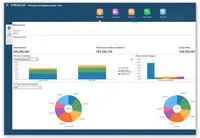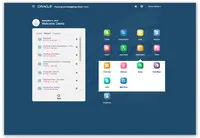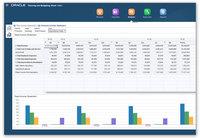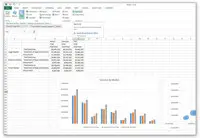Oracle Fusion Cloud Enterprise Performance Management
Starting at $250 per user/per month
View PricingOverview
What is Oracle Fusion Cloud Enterprise Performance Management?
Oracle Fusion Cloud Enterprise Performance Management (EPM) is a solution that helps users model and plan across finance, HR, supply chain, and sales, streamline the financial close process. Oracle Cloud Enterprise Performance Management (EPM) Platform is a framework of the…
Recent Reviews
Awards
Products that are considered exceptional by their customers based on a variety of criteria win TrustRadius awards. Learn more about the types of TrustRadius awards to make the best purchase decision. More about TrustRadius Awards
Popular Features
- Financial budgeting (38)9.797%
- Flat file integration (34)9.696%
- Forecasting (37)8.989%
- Scenario modeling (35)8.686%
Pricing
EPM Standard
$250
Cloud
per user/per month
EPM Enterprise
$500
Cloud
per user/per month
Entry-level set up fee?
- No setup fee
Offerings
- Free Trial
- Free/Freemium Version
- Premium Consulting/Integration Services
Product Demos
Accelerating User Adoption of Oracle Cloud EPM with James Rodgers | EPMIcast Episode 16
YouTube
Features
Return to navigation
Product Details
- About
- Competitors
- Tech Details
- Downloadables
- FAQs
What is Oracle Fusion Cloud Enterprise Performance Management?
Oracle Fusion Cloud Enterprise Performance Management (EPM) is a solution that helps users model and plan across finance, HR, supply chain, and sales, streamline the financial close process. Oracle Cloud Enterprise Performance Management (EPM) Platform is a framework of the technical and functional components shared among Cloud EPM processes.
Oracle Fusion Cloud Enterprise Performance Management Features
Budgeting, Planning, and Forecasting Features
- Supported: Long-term financial planning
- Supported: Financial budgeting
- Supported: Forecasting
- Supported: Scenario modeling
- Supported: Management reporting
Consolidation and Close Features
- Supported: Financial data consolidation
- Supported: Journal entries and reports
- Supported: Multi-currency management
- Supported: Intercompany Eliminations
- Supported: Minority Ownership
- Supported: Local and consolidated reporting
- Supported: Detailed Audit Trails
Financial Reporting and Compliance Features
- Supported: Financial Statement Reporting
- Supported: Management Reporting
- Supported: Excel-based Reporting
- Supported: Automated board and financial reporting
- Supported: XBRL support for regulatory filing
Analytics and Reporting Features
- Supported: Personalized dashboards
- Supported: Key Performance Indicator setting
- Supported: Benchmarking with external data
Integration Features
- Supported: Flat file integration
- Supported: Excel data integration
- Supported: Direct links to 3rd-party data sources
Ad-hoc Reporting Features
- Supported: Drill-down analysis
- Supported: Formatting capabilities
- Supported: Report sharing and collaboration
Report Output and Scheduling Features
- Supported: Publish to Web
- Supported: Publish to PDF
- Supported: Report Versioning
- Supported: Report Delivery Scheduling
Access Control and Security Features
- Supported: Multi-User Support (named login)
- Supported: Role-Based Security Model
- Supported: Multiple Access Permission Levels (Create, Read, Delete)
- Supported: Report-Level Access Control
- Supported: Table-Level Access Control (BI-layer)
- Supported: Field-Level Access Control (BI-layer)
- Supported: Single Sign-On (SSO)
Additional Features
- Supported: Embedded Financial Intelligence
- Supported: Prebuilt Workforce Planning Business Process
- Supported: Prebuilt Capex Planning Business Process
- Supported: Prebuilt Project Financial Planning Business Process
- Supported: Prebuilt Financial Statement Planning Business Process
- Supported: Multi Device Access
- Supported: Close Management with Intelligent Process Automation (IPA)
Oracle Fusion Cloud Enterprise Performance Management Screenshots
Oracle Fusion Cloud Enterprise Performance Management Video
Oracle Fusion Cloud Enterprise Performance Management Competitors
Oracle Fusion Cloud Enterprise Performance Management Technical Details
| Deployment Types | Software as a Service (SaaS), Cloud, or Web-Based |
|---|---|
| Operating Systems | Unspecified |
| Mobile Application | Apple iOS, Android |
| Supported Countries | 100+ countries and regions |
| Supported Languages | Arabic, Danish, German, Spanish, Finnish, French, French Canadian, Italian, Japanese, Korean, Dutch, Norwegian, Polish, Portuguese (Brazilian), Russian, Swedish, Turkish, Simplified Chinese, Traditional Chinese |
Oracle Fusion Cloud Enterprise Performance Management Downloadables
Frequently Asked Questions
Oracle Fusion Cloud Enterprise Performance Management (EPM) is a solution that helps users model and plan across finance, HR, supply chain, and sales, streamline the financial close process. Oracle Cloud Enterprise Performance Management (EPM) Platform is a framework of the technical and functional components shared among Cloud EPM processes.
Anaplan, Workday Adaptive Planning, and BlackLine are common alternatives for Oracle Fusion Cloud Enterprise Performance Management.
Reviewers rate Financial data consolidation highest, with a score of 9.8.
The most common users of Oracle Fusion Cloud Enterprise Performance Management are from Enterprises (1,001+ employees).






